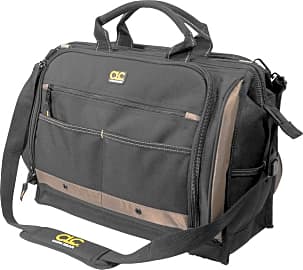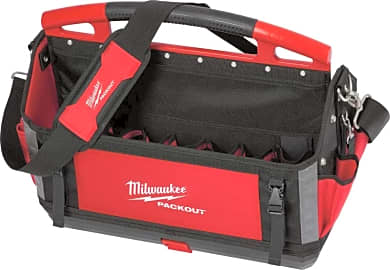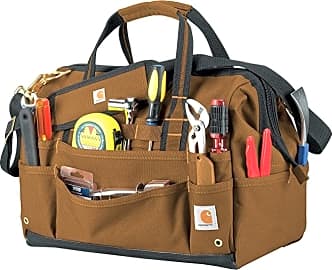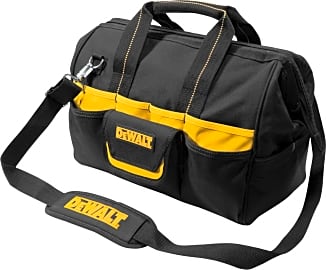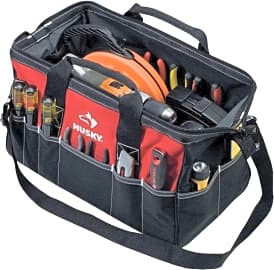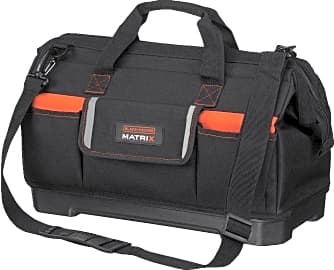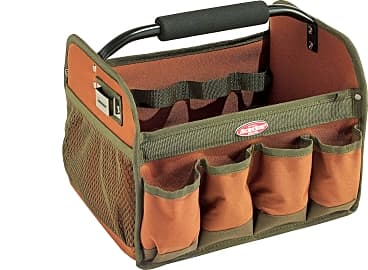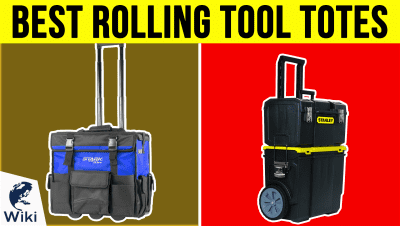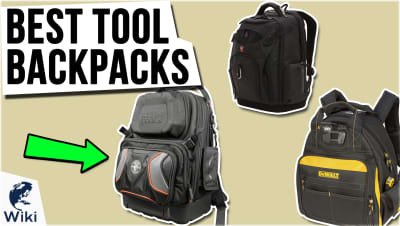The 10 Best Tool Bags

This wiki has been updated 39 times since it was first published in October of 2015. Whether you’re a professional contractor or a dedicated DIYer, our selection of tool bags will provide you with an easy way of toting your gear to the next project in comfort and style. With some durable enough to handle heavy power tools, and all offering sufficient storage space for smaller items, one of these carryalls may help ensure you never lose anything again. When users buy our independently chosen editorial choices, we may earn commissions to help fund the Wiki.
Editor's Notes
March 11, 2021:
We removed the Florida Coast RB15002, noticing that it wasn’t available at the time of this writing and wondering whether it was built well enough for this list, and also ended up eliminating the Occidental Leather, which we ultimately decided wasn’t a fit for this category. Even if it does present a reasonable way to carry a few tools to and from the truck (and looks pretty good doing it), that wasn’t enough for us to consider it a tool bag, and so we had to let it go. It might’ve been a better fit for our list of tool belts.
We added the Carhartt Legacy 16”, maybe because I'm a sucker for that classic Carhartt styling, but more likely because we recognize the quality the company’s known for, and thought it deserved a spot on this list. A 14-inch version of this bag is also available, but it didn't take long to land on this one, as we were already concerned that the 25 pockets offered by the big version might be a bit on the light side, for gadget-laden professionals who’ve been accumulating tools through years of slow collection. By contrast, the Klein Tools 5541610-14 offers 40 pockets, while the Custom LeatherCraft 1539 has 50.
The Milwaukee 48-22-8320 was a model we were excited to add to this list, not because the bag itself is anything spectacular, but because it’s part of the company’s Packout line: a slick set of modular tool boxes that attach securely to one another. This means that you can stack this tool bag on top of your box of fasteners, on top of your box of hand tools, on top of the rolling tool tote that holds your power tools, and wheel them all into your job site in one go — which, needless to say, is pretty sweet. Both of our new additions today are backed by limited lifetime warranties.
Tool bags have had a place in construction industry since time immemorial, and likely always will, but a surprisingly good alternative that’s been gaining traction over the past few years are tool backpacks. After reviewing our list for these a few months ago, I was so impressed by the functionality offered by these options that I purchased the Klein Tools 55485 for myself, and I’ve been raving about it ever since. Admittedly, when it comes to tools most of us like to stick to what we know works, and it’s hard to blame somebody for having that disposition, but if you're an open-minded gearhead who isn’t afraid of trying something new, give tool backpacks some serious thought.
April 24, 2019:
Replaced the ReadyWares Canvas with the Klein Tools Tote. While the ReadyWares was fantastic for hardware storage, there are too many other bags on the market that can hold plenty of tools along with screws and nails, making it hard to justify such a specialized model on a list such as this.
The compact Black & Decker Matrix made a big jump to the #2 spot, as even though it's not capable of holding every tool you could possibly hope to own, it's possibly the best option on the market for transporting the essentials. The Occidental Leather model ahead of it is just a touch classier and more durable, which is why it outpaced it — but you certainly won't go wrong buying the much-cheaper Matrix.
It's hard to find much to quibble with on any of the items listed here, in fact, so much of your decision will hinge on personal preference rather than any product deficiencies. The biggest choice you'll likely need to make has to do with size, and whether you'd rather lug around a huge-yet-heavy bag like the Custom LeatherCraft 1539, or if you'd prefer to spare your back at the expense of tool selection with something like the Florida Coast RB15002.
Special Honors
PromotionsNOW If you're looking to have some merchandise made to help market your brand or company, why not forego the usual pens and t-shirts and peruse this company's selection of Utility Totes and Tool Bags? They may not have something for every professional, but many tradespeople are still likely to find an option they like promotionsnow.com
Klein Tools Backpacks Granted, you might take some flack from your crew for looking like you're waiting for the school bus, but that doesn't stop tool backpacks from presenting a practical alternative to traditional bags, completely enclosing your gear and freeing up both your hands to carry material from the truck while your tools are on your back. Klein Tools has one of the best selections available, offering models in a number of sizes. kleintools.com
What Do I Need to Know Before I Buy a Tool Bag?
Take note of whether certain items will hang loose on metal hooks, or individual ringlets.
The first thing anyone needs to consider before shopping for a tool bag is what they'll need that bag to hold. Make a list of all the tools that you'd like to have at your disposal. Once you've done that you can begin to narrow your search based on which tool bags are capable of carrying that load.
As you begin to research bags, take note of how many compartments each model has to offer. Take note of whether those compartments fasten, zip, or snap. Take note of whether certain items will hang loose on metal hooks, or individual ringlets. And take note of whether the center of the bag has been hollowed out, or divided into halves.
You'll want to compare each tool bag's maximum weight capacity against the weight of the equipment that you'll need that bag to hold. In addition, you'll want to determine whether a tool bag features one long strap or two. Having two long straps is advantageous, in that it will allow you to distribute that bag's weight across both shoulders.
Along those lines, be sure to confirm that any tool bag you might be interested in has been designed by using durable materials. Most top-of-the-line bags are made out of reinforced nylon or polyurethane, with certain bags featuring a leather trim around the border. As a precaution, make sure the bag comes with a warranty. That warranty may be the only thing to fall back on if the bag does not live up to expectations.
How To Organize Your Tool Bag Efficiently
Most tool bags are made to be organized from the outside-in. That is to say, you want to use the outside compartments for the tools you use the most, while reserving the inside pockets for any minor items you'll only reach for in a pinch.
Keep in mind that one side of the bag will inevitably be brushing up against your body.
It's important to consider which shoulder you'll be carrying the tool bag on. Keep in mind that one side of the bag will inevitably be brushing up against your body. You'll want to avoid filling the outer compartments of that side with any jagged objects. If you fill a pocket with nails, it helps to carry around a magnet. That magnet will allow you to gather in some of those nails without having to dig into the pocket.
Another convenient way to keep you and the tool bag efficient, is by keeping accordant objects stored together; take for example, a tape measure and a pencil, a hammer in close proximity with nails.
Ideally, you should keep larger items in the center of the bag, with accessories and attachments around the sides. As for sharp objects, it's best to keep them holstered at your sides, and avoid carrying combustible materials. Make sure to press the lids down tight on any aerosol cans. Of course these are not strict guidelines, as one's tool placement preference differentiates from person to person.
Once a month, you'll want to remove any of the bag's unused items, while replenishing any of the items that have started running low. Make a point to keep a few of the bag's compartments empty, just in case you need to pick up some new hardware or equipment on the go.
A Brief History of The Tool Bag
Tools have been around ever since man realized they could produce and utilize them. While some of these tools are as rudimentary as a sharpened stone or bone, it's safe to suggest prehistoric cavemen may have invented a sack to contain their personal items. The Australian Aboriginals, for example, were known to handcraft what are now referred to as dillybags. These bags featured deep pockets,and were abrasive to the touch due to the plant material they were made from.
This bag was tight, which resigned people to feeling around as if they were in the dark.
Artisans throughout Ancient Greece, on the other hand, were known to carry their tools inside a gunny sack. The gunny straps were usually bound together so the artisan could easily reach for whatever tool he wanted.
Handymen throughout the Gilded Age in America considered it apropos to carry their tools inside a leather satchel. This began to change, however, during the Industrial Revolution, as a rise in manufacturing and construction (not to mention production of utilities) led to an increased demand for professional tool belts.
In 1916, an American inventor named Myron Simpson was awarded the first-ever patent for a "construction tool bag." Simpson's bag looked like a briefcase, and it was handcrafted out of brown leather. Simpson's bag featured a wide flap and a pair of fasteners across the front. Inside, the bag featured a series of pockets, each of which was sewn into the interior. Locating a specific implement in Simpson's bag was not very easy. This bag was tight, which resigned people to feeling around as if they were in the dark.
Today, tool bags have become an essential part of any handyman's arsenal. Tool bags are preferable to tool belts for larger jobs, in that the tool bag will allow one to carry more equipment (if not the tool belt, itself).


